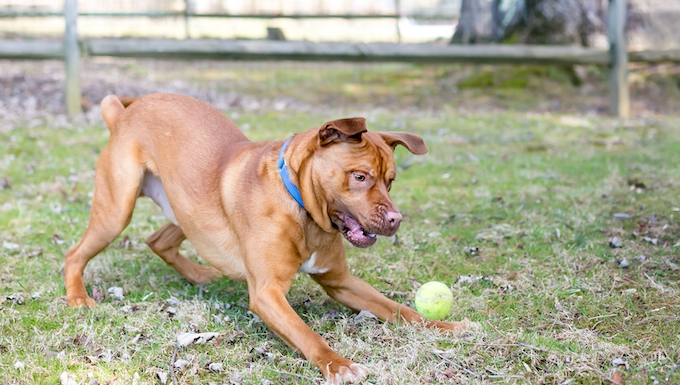
Researchers at the University of British Columbia (UBC) aim to increase dog adoption rates.
To achieve this, Dr. Sasha Protopopova and her colleagues study how shelter dogs and potential adopters behave. Their ongoing research has identified behaviors important to potential adopters. The researchers then use their findings to implement training programs that target and encourage such behaviors.
Uncovering Why Dogs Do What They Do
Protopopova is director at the Human-Animal Interaction Lab at UBC that opened in September 2022. By inviting dogs and their pet parents to engage in canine cognition research, their goal is to “uncover knowledge about why dogs do the things they do and how do we determine the individual differences of specific dogs,” says Protopopova.
For instance, one experiment involves the “touch” command, where the pup is taught to touch its nose to the palm of the owner’s hand. The researchers might then change the rules by having the dog learn to touch both palms of the owner’s hand. They would then note how long it takes the dog to both learn the task and adapt to the new rules. And that knowledge would translate to improved quality of life, increased adoptability, reduced length of stay, and more animals placed successfully in loving homes.
Encouraging Adoptable Behavior
Over three million dogs are admitted to shelters each year in the U.S. alone, and approximately 390,000 are ultimately euthanized, according to the ASPCA. The high risk of death combined with the number of animals held in shelters is a significant animal welfare concern. Protopopova’s goal as a behavior analyst is to improve animal shelter practice and animal welfare in shelters.
The researchers observed nearly 300 dogs at an animal shelter. They determined that certain behaviors usually meant a longer length of stay. “We found that dogs that leaned or rubbed on the enclosure wall, faced away from the front of the enclosure, and engaged in back and forth motion stayed longer at the shelter,” Protopopova told the Cambridge Center for Behavioral Studies back in 2014. “After discovering which behaviors were potentially important to adopters, we found that simply tossing food in the kennels when people walked by decreased these inappropriate behaviors. Furthermore, when this simple method was applied to an entire shelter containing 70 dogs, we saw a 68 percent decrease in the number of dogs behaving inappropriately.”
Using Play Signals to Increase Dog Adoption Rates
In 2000, another animal welfare and behavior researcher questioned dog-human play. Nicola Rooney and her colleagues wanted to know whether dogs respond to peoples’ play signals. In the study, volunteers played with their dogs for five minutes in the comfort of their homes. Owners were asked to play with their dog as they did normally. However, they were not allowed to use objects or toys.
The results were sobering. People do not always use play signals that result in play. Moreover, people are unlikely to adopt a dog who does not respond to their play signals. Patting the floor was used the most often, but play followed only 38 percent of the time. The same went for scruffing the dog and clapping. Chase-and-running-away as well as lunging forward were associated with play 100 percent of the time.
“Signaling up” (tapping one’s chest to entice the dog to jump up), grabbing or holding a dog’s paws, and play bowing were also successful at eliciting play. The researchers concluded that humans often use ineffective [play] signals. “Instead of blaming dogs for ‘not playing right,’ people could look at their own behavior and evaluate its effect, acknowledging that certain play signals are more effective at eliciting play than others,” said Rooney, and reported by Scientific American.
More Play Equals Higher Adoption Rate
Both Rooney’s and Protopopova’s studies suggested that people are not very good at playing with their dogs. “Instead of training dogs to play, we decided to give dogs a voice by asking what kinds of games dogs preferred and then training the adopters to play those specific games,” Protopopova said. “We found that encouraging potential adopters to play with the dogs’ preferred toy resulted in more social play during interactions and in almost a 70 percent higher adoption rate.”
Protopopova’s research actually began years ago. “When I was a student 15-20 animals came into the shelter per day but there were only a few adoptions. There wasn’t enough staff to provide proper care, so we focused on what adopters look for in dog, hoping that some behavioral programs will encourage adoption,” she said.
“Sentimentally, people want to be chosen by that dog. The two major signs of adoption are whether the dog lays down near you, and the dog doesn’t reject play. Our recent study looked at both adopters and dogs’ behaviors. Then we trained dogs to lay down and asked dogs for their favorite toys or whether they didn’t want to play at all — the latter could be their personality but I suspect stress … Dogs lying close to the person were about 14 times more likely to be adopted, and a dog who ignored a person’s play initiation was unlikely to be adopted.”
Advice for Potential Adopters
Keep in mind that most shelter dogs are living in a new, often bleak environment. They are stressed out, and meeting potential adopters is like speed dating — that first encounter adds more stress. As Protopopova notes, different breeds of dogs and dogs with different characteristics respond differently to prompts. Please think about your prompts — your play signals — as well as theirs.
More About Dr. Protopopova
Protopopova is Assistant Professor, Animal Welfare Program at UBC and an applied behavior analyst. Prior to and during her university studies, she worked as a dog trainer. She taught a variety of classes and also provided dog behavior consulting for animal shelters. Protopopova is also a certified applied animal behaviorist. She has spent her career investigating domesticated animals, including how to adapt pets to a changing climate. Protopopova spends her days conducting behavioral research, teaching university classes in animal learning, going on hiking trails, and cuddling dogs.









